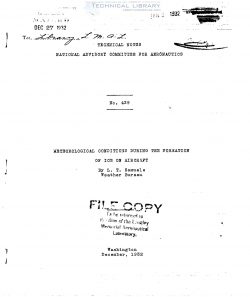naca-tn-439
- Version
- 131 Downloads
- 1.42 MB File Size
- 1 File Count
- November 25, 2016 Create Date
- November 25, 2016 Last Updated
National Advisory Committee for Aeronautics, Technical Notes - Meteorological Conditions During the Formation of Ice on Aircraft

The hazard resulting from the formation of ice on
airplanes makes it highly desirable to ascertain all pos—
sible meteorological information pertinent thereto in or-
der togavoid or prevent its formation. The object of
this‘paper is‘t6—§?3§§nt the results-of a number of rec—
ords recently secured from autographic meteorological in-
struments mounted on airplanes at times when ice formed.
Ice is found to collect on an airplane in appreciable
amounts gnly when the airplane is in some form of visible
moisture, such as cloud, fog, mist, rain, etc., and the
air temperature is within certain critical limits.
There are two principal types of ice formation that
collect under such conditions, and in view of the different
effects of each of these on a plane they Will be discussed
separately under their respective headings, viz., clear
ice and rims.
Clear ice.~ This is the same type as that commonly
known as'glaze,“ which forms on the ground, trees, and
other objects from rain when the temperature of these ob-
Jects is below 0° C. It usually is_smooth and glassy in
appearance, but when mixed with SROW‘br sleet it may be
rough; also, when .freezi-ng takes- place slowly, ridge_s are
likely to form.
This deposit usually is heaviest on the en_tering edge
of the plane where _it aesumes a blunt-nosed shape tapering
off toward the rear, Occasionally the wings are ice—coat—
ed on both top and bottom with icicles along the trailing
edge. In most cases the ice adheres firmly to the surface
of the airplane.
Rimeg— Rims consists Of hard, whitish, opaque ice pel—
lets or grains, frequently intermixed with a frost forma-
tion of light feathery crystalline structure. From obser—
vitions of rime deposits on mountains, Kohler (reference 1)
déscribed the formation as snow—white, plug—like, truncated
sense with the small and toward the surface upon which it
is deposited. The plugs showed a fibrous structure and
occasionally shiny surfaces. The particles from which the
plugs were composed were firmly held together but the
plugs themselves could easily be separated from one an—
other.
| File | Action |
|---|---|
| naca-tn-439 Meteorological Conditions During the Formation of Ice on Aircraft.pdf | Download |

Comment On This Post